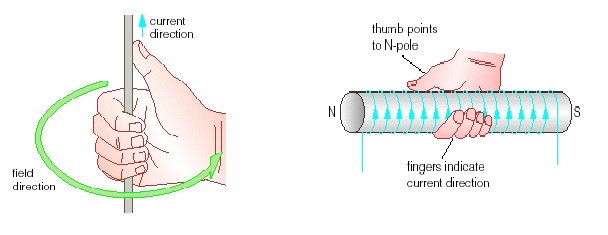Magnetism, Magnetic Poles, and Electromagnetism
The source of all magnetism is moving charges. Magnetic materials have north and south poles. Magnetic field lines move toward the north pole on the inside and the south pole on the outside.
Materials have what are called domains, which are groups of atoms whose electrons are spinning in the same direction. Domains are typically oriented in all different directions. When an object becomes magnetized, its domains align, giving it north and south poles.
You may be wondering then, why all materials aren't magnetic. The answer is simple: not all materials have domains.
Knowing about north and south magnetic poles, we know why the northern lights occur. Harmful particles called cosmic rays sometimes hit the earth's atmosphere. We are not negatively affected, because the earth itself has magnetic poles, so the particles hit the earth's magnetic field and spiral along the field lines to the poles. The beautiful waves of light and color seen are the result of these cosmic rays.
Much like with positive and negative charges, like poles repel and opposite poles attract. This is because, when north and south pole are near one another, their field lines are moving in the same direction. The opposite can be said when two north or two south poles are near one another.
So, how does something become magnetized? A common example of an object being magnetized is a paperclip and a magnet:
Domain in a paperclip are random. A magnet has a magnetic field. When the magnet gets close to the paperclip, the domains of the paperclip align with the magnetic field of the magnet. The paperclip now has north and south poles. The north pole of the paperclip is attracted to the south pole of the magnet, so the paperclip stick together. The paperclip can become unmagnetized if it exposed to heat or jostled, because the domain become unaligned.
An electromagnet is a current-carrying coil of wire. Its strength is increased by increasing the number of turns in the coil and the current.
Forces on Charged Particles in an Electric Field; Motors
Particles in an electric field are moving and are affected by a magnetic field. We can use the right hand rule to find the direction of the magnetic field. Point your thumb in the direction of the particle's movement, and curl your finger's around. Your curling fingers are the direction of the magnetic field.
For information on how a motor works, refer to my previous post, in which I describe the lab where we made a simple motor.
Electromagnetic Induction
Electromagnetic Induction is when voltage is induced by changing the magnetic field in loops of wire.
The more coils in an electromagnet, the more voltage is induced.
A common example of electromagnetic induction is the use of credit cards. Credit cards have magnetic strips with sectors oriented in different ways. A card reader has small coils of wire, which are induced with voltage when the card slides through. These electrical signal from the card are interpreted by the reader into a code.
Generators and Energy Production
Generators produce energy through electromagnetic induction. This is usually done by rotating a coil with a stationary magnetic field. The difference between a generator and a motor is that a generator transforms mechanical energy (input) into electrical energy (output), while a motor does the opposite. They are both made of could of wire and magnets, and they both work through electromagnetic induction.
Transformers
A transformer is a device for increasing or decreasing voltage or transferring electric power from one coil of wire to another by means of electromagnetic induction. Transformers have an input (primary) and an output (secondary). They are used to either step up (increase) or step down (decrease) voltage. Stepping up voltage decreases current and stepping down voltage increases current. In order for voltage to be stepped up, the secondary coil of wire must have more turns than the primary coil. For voltage to be stepped down, the secondary coil of wire must have less turns than the primary coil.
primary voltage/number of turns = secondary voltage/number of turns
Step up:
Step Down:
Whether the voltage is stepped up, stepped down, or the same the power in and out will always be equal.
power into primary = power out of secondary
Electric power equals voltage (V) times current (I). This means,
VI primary = VI secondaryWe can use this equation to solve or unknown current or voltage in the system.
Note: Transformers and generators must both use alternating current (AC). This is because both function from electromagnetic induction, which occurs when the magnetic field changes. In order for the magnetic field to change, the current must alternate.
My problem solving skills, effort, and learning…
In this unit, I have completed all of my assignments on time and prepared well for all assessments. I learned about magnetism and how much it affects everyday life. I didn't realize how much it had to do with electricity and power companies.
Goals…
-to prepare well and ace the exam!







No comments:
Post a Comment